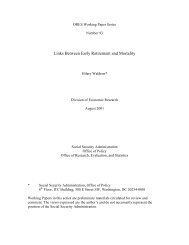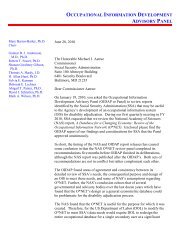Table A-3.Coefficients and standard errors from multinomial logit estimations of occupational choice—ContinuedOccupation andvariableNon-SSI recipients with—SSI recipientsNo disabilityAny disabilityWork disabilityStandardStandardStandardStandardCoefficient error Coefficient error Coefficient error Coefficient errorN 2,745 1,180,588 72,686 18,414Wald chi2(252)(144)(252)(234) 31,871.16 376,139.87 21,407.64 5,561.22Prob>chi2 0.0000 0.0000 0.0000 0.0000Pseudo R2 0.1213 0.1316 0.1166 0.1117Log pseudolikelihood-5,866.55-2,782,603.70 -173,140.86 -44,143.96SOURCE: Author's calculations using the 2007 American Community Survey using sample weights.NOTES: Office and administrative support is the base outcome.. . . = not applicable.NotesAcknowledgments: The author would like to thankRichard Balkus, Susan Grad, John Kearney, Chris Silanskis,John Hennessey, L. Scott Muller, Paul O’Leary, andJim Sears for their helpful comments and suggestions.12007 dollars are used because the data in this study arefrom 2007.2For more information on the work incentives for SSIrecipients see the Red Book: A Summary Guide to EmploymentSupport for Individuals with Disabilities under the<strong>Social</strong> <strong>Security</strong> Disability Insurance and Supplemental<strong>Security</strong> Income Programs, available at http://www.socialsecurity.gov/redbook.3Almost all SSI recipients are automatically eligible forMedicaid.4Scott (1992) matched industry information to administrativeSSI recipient data, but no information can be usedto identify beneficiary occupations from administrativerecords.5O*NET is the Occupational Information Network,which lists standardized occupational descriptions and isreplacing the Dictionary of Occupational Titles. See http://www.onetcenter.org for more information.6The NSCF is a survey of individuals up to age 26who currently or formerly received SSI payments or whoapplied but were denied eligibility (and their families).The NBS is a survey that is part of SSA’s evaluation of theTicket to Work initiative and gathers information on Ticketparticipants and the national beneficiary population. Moreinformation on the NSCF is available from http://www.socialsecurity.gov/disabilityresearch/nscf.htm and for theNBS from http://www.socialsecurity.gov/disabilityresearch/ttw2/appendixC.htm.7For example, even with an oversample of SSI recipients,the 2001 SIPP only included 1,614 working-age SSIrecipients, 10.3 percent of whom were working (DeCesaroand Hemmeter 2008).8The long form of the 2000 Decennial Census also hasa sufficiently large sample of SSI recipients and containsthe information necessary for a comparison with these ACSresults.9See Weathers (2005) for more information on disabilitystatistics and the ACS. Note that there is a largedifference between SSA’s definition of disability and theACS’s definition(s) of disability, particularly of “mental”disabilities.10Here and throughout the article, unemployment isdefined as an individual who is without a job, but is lookingfor work.11See http://www.bls.gov/soc/home.htm for informationon SOC codes.12In 2006 there were only 696,472 RR beneficiaries,and over a fourth of them were aged (Railroad RetirementBoard 2008). Any concurrent recipients are thus most likelyOASDI, and specifically DI, beneficiaries.13Multinomial logit models require that choices be madeindependently of other options available (the independenceof irrelevant alternatives (IIA) assumption). Although thesemodels are common in the occupational choice literature,the IIA assumption is rarely tested. Alternatives, suchas the nested logit model are not feasible for this studybecause no information is known about the characteristicsof the occupations themselves. Also, multinomial probitmodels are not computationally feasible with the currentdata. Formal tests of IIA are largely inconclusive regardingthe appropriate occupation groupings. However, theestimates using only the six broad occupation groups —(1)72 <strong>Social</strong> <strong>Security</strong> Bulletin • Vol. 69 • No. 3 • 2009
management, professional, and related; (2) service; (3) salesand office; (4) farming, fishing, and forestry; (5) construction,extraction, maintenance, and (6) repair; production,transportation, and material moving)—which are morelikely to be independent of irrelevant alternatives, yieldsubstantively similar results, suggesting IIA may not be aconcern when the narrower occupations groups are used.Results using the six broad occupation groups are availablefrom the author upon request.14See Blau and others (1956) for a fuller description ofoccupational-choice and selection models. Most occupational-choicemodels also include relatively few variables;most other variables not included in the model estimatedhere are likely a result of occupational choice.15Unfortunately, significance tests for the dissimilarityindex are currently severely problematic. This wouldrequire estimating the mean and variance of the index,and, although there are some methods for doing this, allare problematic. See Mulekar, Knutson, and Champanerkar(2008) for a recent review of these methods.16All estimates in this article use the sample weightsprovided in the survey.17Thornton and others (2008) also found that 11 percentworked in food preparation and serving, 10 percent workedin office and administrative support, 5 percent worked insales, 3 percent worked in personal care and services, and22 percent worked in “other” occupations.18The means and standard errors of the variables used inthe models are presented in the Appendix (Table A-2), andthe estimated models are presented in Table A-3. Standarderrors are not included in the predicted distributions forbrevity, but are available from the author upon request.Balanced repeated replicate weights are not utilized in theestimation of the occupational-choice models, althoughthe base weights are used. This was done for two reasons.First, the computational capacity needed to utilize theseweights is prohibitively large. Second, because this study isnot interested in the significance of the individual covariatesin the model, per se, the correct standard errors are notneeded. The use of the base weights yields the same pointestimates for the coefficients and thus the predicted valuesfrom the model are identical to when balanced repeatedreplicate weights are used.19Although the coefficients for the estimated models arenot identical (see Table A-3), the predicted occupationaldistributions for the work-disability population under theany-disability and work-disability models are identical. Theany-disability approach produces the mean predicted valueby estimating the model for those with and without a workdisability and includes a dummy variable on the right-handside of the regression that indicates whether a person hasa work-related disability. This approach generates meanpredicted values by predicting values for only those witha work disability (in this case) and taking the mean ofthose predicted values. The dummy variable allows one toseparate out the mean predicted value for those with a workdisability from the mean predicted value for those without adisability. The difference between the two is determined bythe coefficient on the dummy variable. The work-disabilityapproach produces mean predicted values by estimating amodel with the same right-hand side variables (except forthe work-disability dummy, which is not identified in thismodel), but for only those with a work-related disability. Itthen takes the mean of the predicted values for those witha work disability. Thus, when the any-disability model isrestricted to the work-disability population, the occupationaldistribution will be identical to that of the actualwork-disability population.ReferencesAutor, David H., and Mark G. Duggan. 2003. The rise inthe disability rolls and the decline in unemployment.Quarterly Journal of Economics 118(1): 157–205.Blau, Peter M., John W. Gustad, Richard Jessor, HerbertS. Parnes, and Richard C. Wilcock. 1956. Occupationalchoice: A conceptual framework. Industrial and LaborRelations Review 9(4): 531–543.Bound, John. 1991. Self-reported versus objective measuresof health in retirement models. Journal of HumanResources 26(1): 106–138.Brown, Randall S., Marilyn Moon, and Barbara S. Zoloth.1980. Occupational attainment and segregation by sex.Industrial and Labor Relations Review 33(4): 506–517.Burkhauser, Richard V., Mary C. Daly, and Andrew J.Houtenville. 2002. How working age people with disabilitiesfared over the 1990s business cycle. In Ensuringhealth and income security for an aging workforce,Peter P. Budetti, Janice M. Gregory, H. Allan Hunt, andRichard V. Burkhauser, eds., 291–346, Kalamazoo, MI:W.E. Upjohn Institute for Employment Research.Burkhauser, Richard V., and Andrew J. Houtenville, andDavid C. Wittenburg. 2003. A user’s guide to currentstatistics on the employment of people with disabilities.In The decline in employment of people with disabilities:A policy puzzle, David C. Stapleton and Richard V.Burkhauser, eds., 23–85. Kalamazoo, MI: W.E. UpjohnInstitute for Employment Research.Burkhauser, Richard V., Mary C. Daly, and Andrew J.Houtenville. 2002. Self-reported work-limitation data:What they can and cannot tell us. Demography 39(3):541–555.Burkhauser, Richard V., and David C. Stapleton. 2003.Introduction. In The decline in employment of peoplewith disabilities: A policy puzzle, David C. Stapleton andRichard V. Burkhauser, eds., 1–20. Kalamazoo, MI: W.E.Upjohn Institute for Employment Research.<strong>Social</strong> <strong>Security</strong> Bulletin • Vol. 69 • No. 3 • 2009 73
- Page 1 and 2:
Social SecuritySocial SecurityBulle
- Page 3:
Social SecurityBulletin Vol. 69, No
- Page 6 and 7:
Perspectives77 An Empirical Study o
- Page 8 and 9:
Selected Abbreviations—continuedM
- Page 10:
within the next few years (Aglira 2
- Page 14 and 15:
coverage varies significantly by ra
- Page 16 and 17:
non-Hispanic white, and college edu
- Page 18 and 19:
same groups (Table 6). For the last
- Page 20 and 21:
from DB to DC pensions is accelerat
- Page 22 and 23:
Table 8.Percent of individuals who
- Page 24 and 25:
not necessarily the largest gains a
- Page 26 and 27:
shoring-up DB plans before those pl
- Page 28 and 29: Table B-1.Percent change in mean pe
- Page 30 and 31: Table B-3.Percent of individuals wh
- Page 32 and 33: ReferencesAaronson, Stephanie, and
- Page 35 and 36: Social Security Administration’s
- Page 37: Chart 1.Historical expansion of Soc
- Page 40 and 41: self-employment information for the
- Page 42 and 43: (Cronin 1985). The final earnings r
- Page 44 and 45: prior to 1950, first year of earnin
- Page 46 and 47: average indexed monthly earnings (A
- Page 48 and 49: 13For an explanation of how the sel
- Page 50 and 51: Kopczuk, Emmanuel Saez, and Jae Son
- Page 53 and 54: Occupations of SSI Recipients Who W
- Page 55 and 56: on the differences between the occu
- Page 57 and 58: prediction models. Table A-1 lists
- Page 59 and 60: Occupational Distributions of theEm
- Page 61 and 62: similar, only 4 percent of the popu
- Page 63 and 64: Table 5.Estimated occupational dist
- Page 65 and 66: Table 7.Predicted Herfindahl-Hirsch
- Page 67 and 68: Table 9.Estimated occupational dist
- Page 69 and 70: Table 11.Average annual wages of wo
- Page 71 and 72: Table A-2.Means and standard errors
- Page 73 and 74: Table A-3.Coefficients and standard
- Page 75 and 76: Table A-3.Coefficients and standard
- Page 77: Table A-3.Coefficients and standard
- Page 81: Stapleton, David C., Nanette Goodma
- Page 84 and 85: Selected Abbreviations—continuedO
- Page 86 and 87: The 1983 Amendments to the Social S
- Page 88 and 89: Chart 1.Proportion of new claimants
- Page 90 and 91: Table 4.The evolution of the ARF an
- Page 92 and 93: for the test of equality of means b
- Page 94 and 95: Table 8.Average monthly Social Secu
- Page 96 and 97: in the chart, especially for men, t
- Page 98 and 99: 6This is a very important character
- Page 100 and 101: Benítez-Silva, Hugo, Berna Demiral
- Page 103 and 104: OASDI and SSI Snapshot andSSI Month
- Page 105 and 106: Monthly Statistical Snapshot, Augus
- Page 107 and 108: Table 2.Recipients, by eligibility
- Page 109 and 110: SSI Federally Administered Payments
- Page 111 and 112: Table 7.Average monthly payment, by
- Page 113: Awards of SSI Federally Administere
- Page 116 and 117: Copyright—Authors are responsible
- Page 119 and 120: Program Highlights, 2009Old-Age, Su








